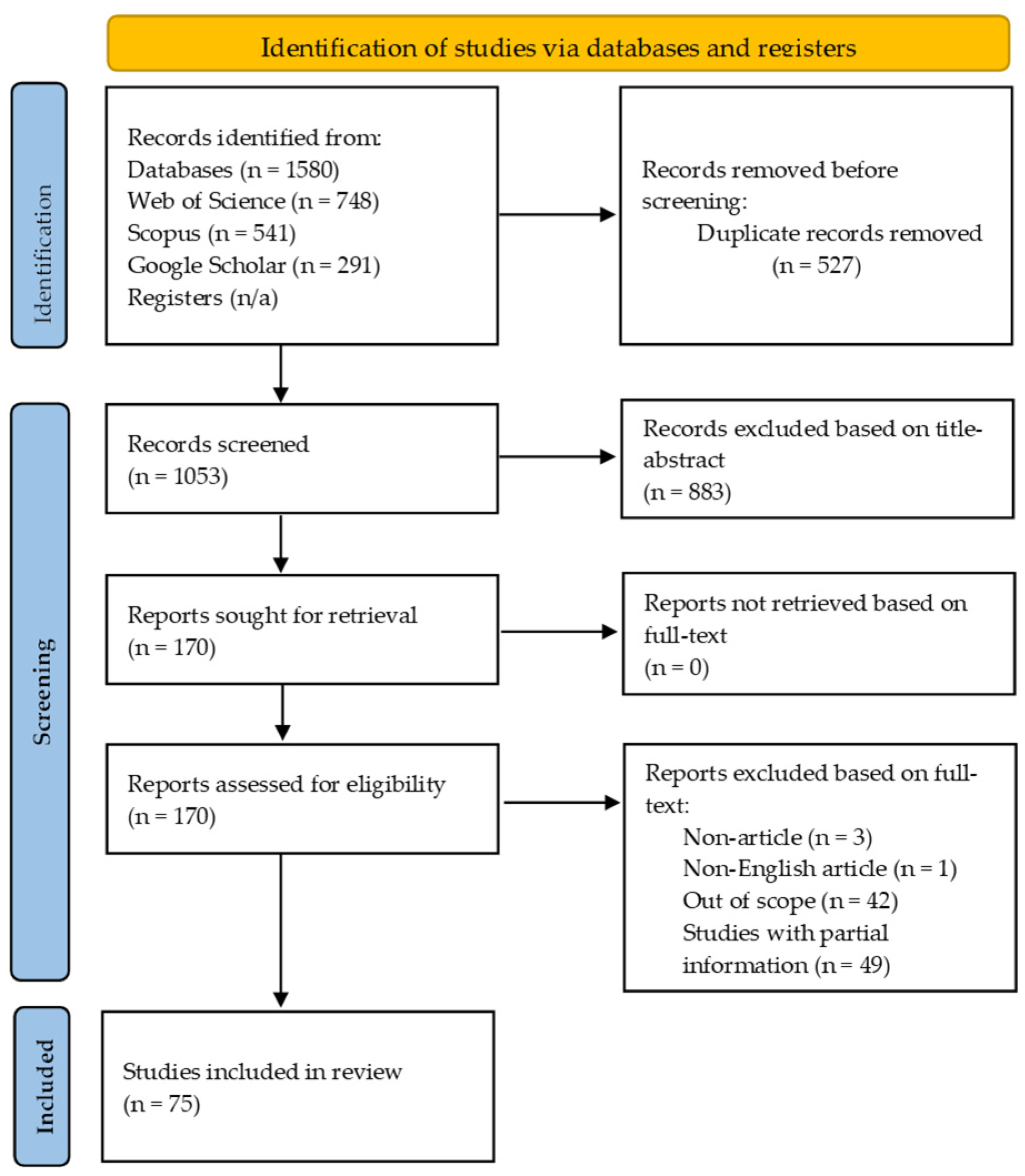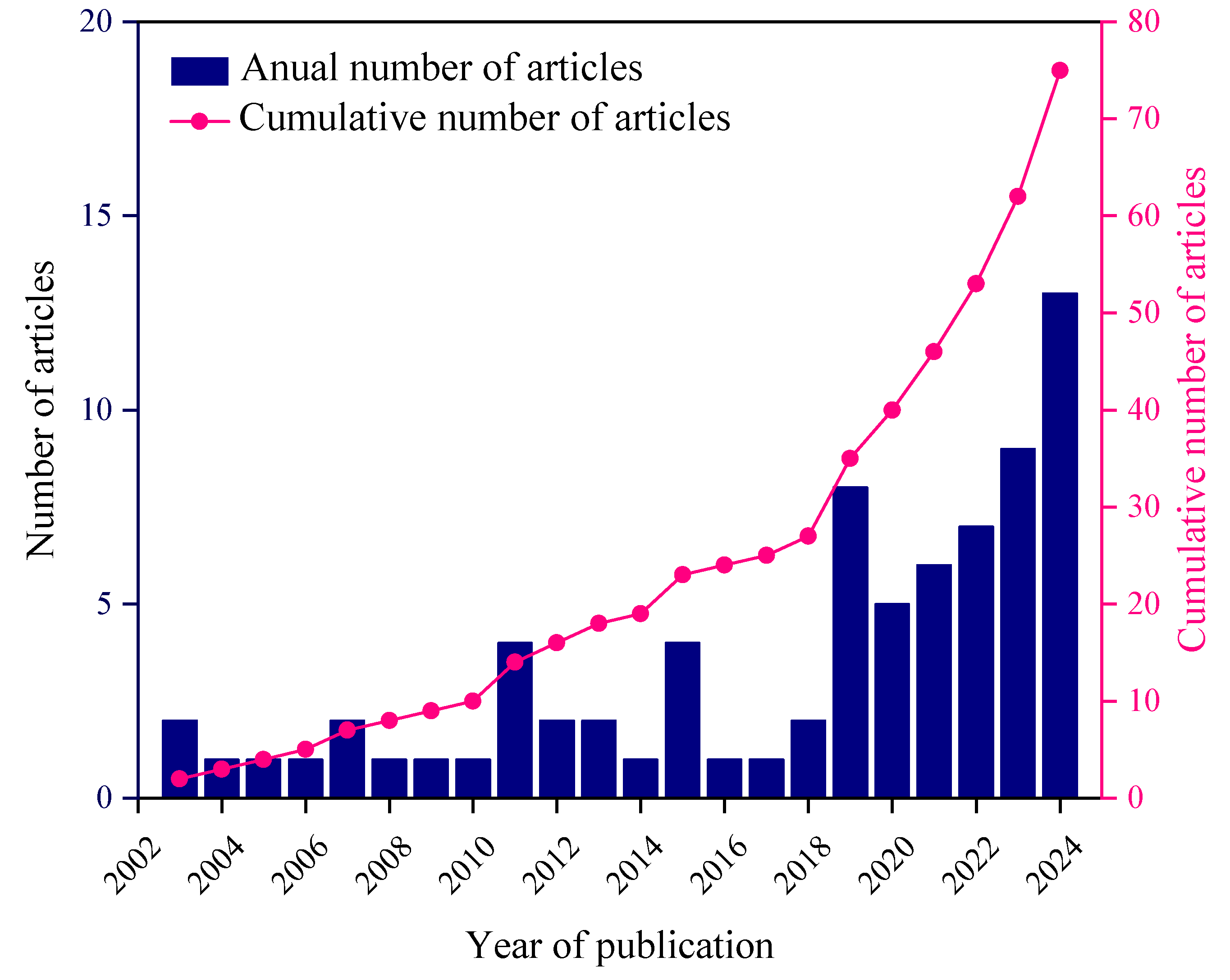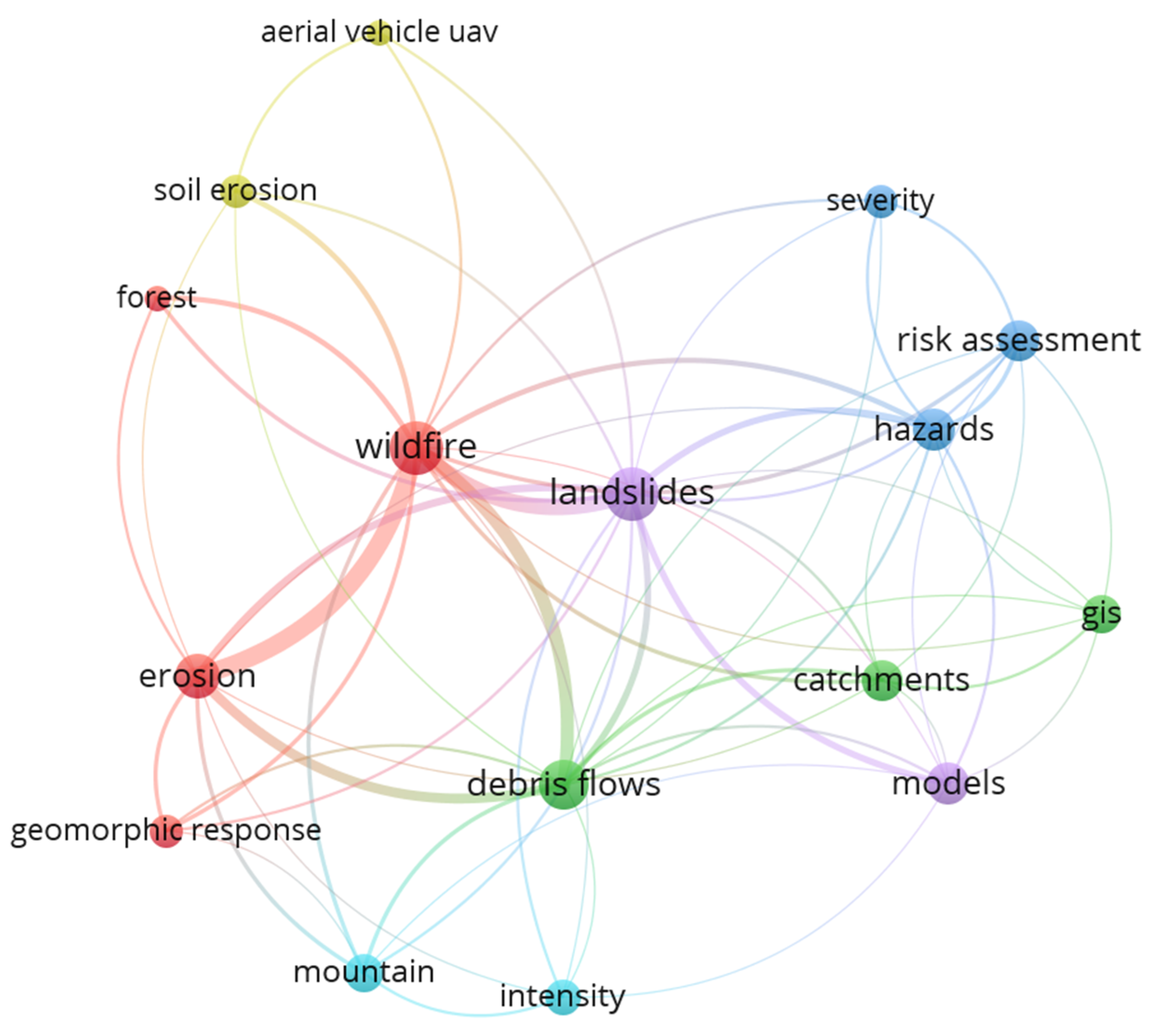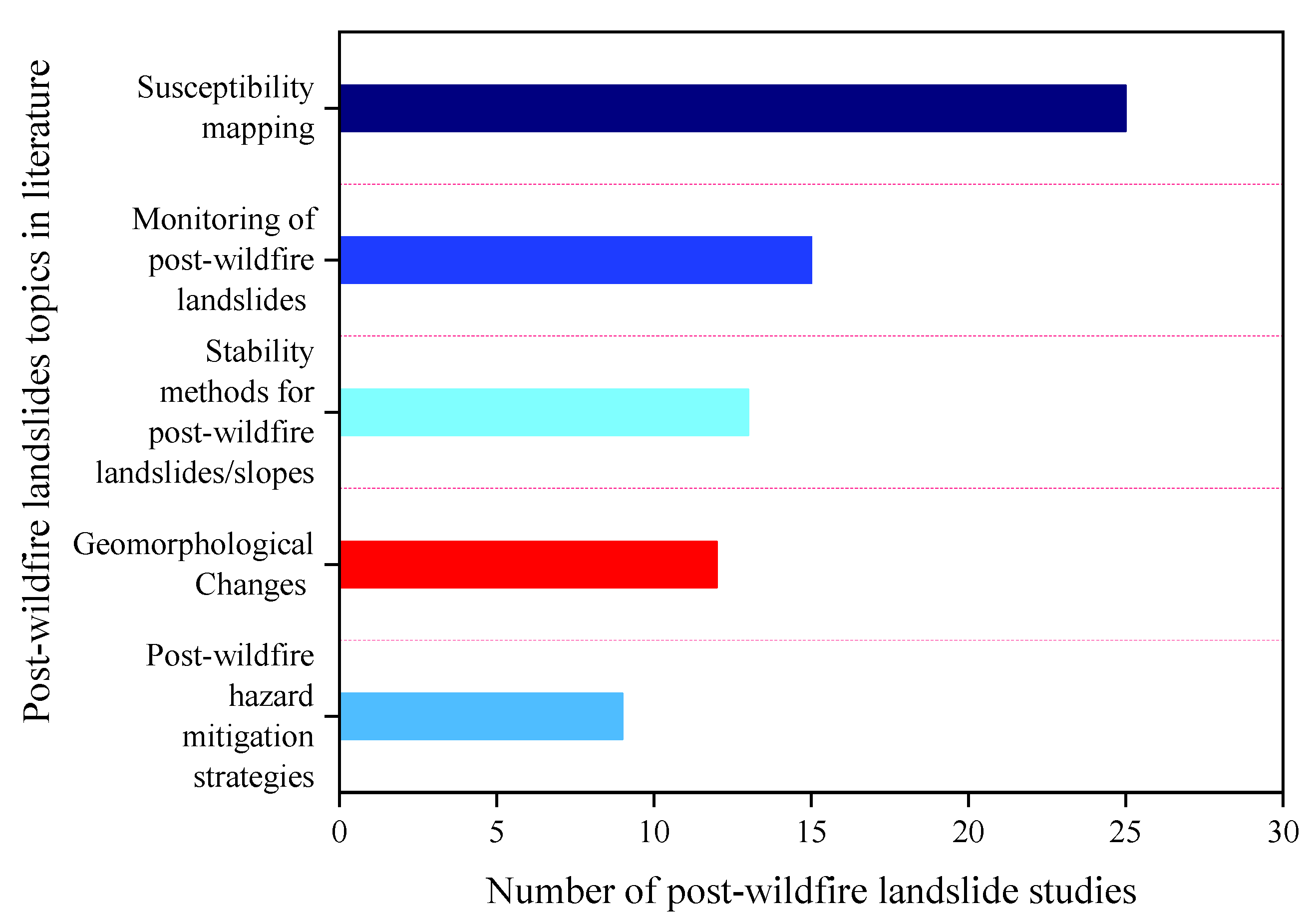Systematic Review of Post-Wildfire Landslides
Abstract
1. Introduction
- What are the current research trends in post-wildfire landslides?
- What are the existing research gaps in post-wildfire landslides in the literature?
- What measures are available to mitigate post-wildfire landslides?
2. Systematic Review Methodology
2.1. Literature Search Process
2.2. Study Selection Process
2.3. Publication Information and Types
2.4. Geographical Distribution
2.5. Keyword Co-Occurrence Analysis
2.6. Characterization of the Selected Research Articles
- Susceptibility mapping;
- Monitoring of post-wildfire landslides;
- Stability methods for post-wildfire landslides and slopes;
- Geomorphological changes caused by post-wildfire landslides;
- Post-wildfire landslide hazard mitigation strategies.
3. Results
3.1. Exploring the Review Subtopics
3.1.1. Susceptibility Mapping of Post-Wildfire Landslide
3.1.2. Monitoring of Post-Wildfire Landslide
3.1.3. Stability Methods for Post-Wildfire Landslides
3.1.4. Geomorphological Changes Caused by Post-Wildfire Landslides
3.1.5. Post-Wildfire Landslide Mitigation
4. Discussion
5. Conclusions
- The models available in the literature for mapping, detecting, and monitoring landslides after wildfire events are region-specific, making them inapplicable in different geological and climatic conditions. Therefore, studies should be conducted to extend the geographical scope, accounting for complex climatic and geo-environmental conditions.
- More studies such as field experiments should be conducted and other possible environmentally friendly stabilization methods should be employed such as biopolymer, geosynthetic materials, temporary barriers, and natural fibers to stabilize terrains affected by fires and their short-term and long-term effectiveness should be investigated.
- Studies should be conducted to integrate advanced remote sensing and machine learning approaches to improve landslide susceptibility mapping, prediction, and monitoring in geological environments.
- Attention should be given to more case studies on the stability and mitigation of post-wildfire landslides, especially on engineering solutions for stability and mitigation, as few case studies have been presented in the literature [52].
Author Contributions
Funding
Data Availability Statement
Acknowledgments
Conflicts of Interest
Abbreviations
| SVM | Support Vector Machine |
| ICA | Imperialist Competitive Algorithm |
| UAV | Unmanned aerial vehicle |
| GIS | Geographic information system |
| ANN | Artificial neural network |
| RF | Random forest |
| GBM | Generalized boosted model |
| MaxEnt | Maximum entropy |
References
- Nyman, P.; Sheridan, G.J.; Smith, H.G.; Lane, P.N.J. Evidence of Debris Flow Occurrence after Wildfire in Upland Catchments of South-East Australia. Geomorphology 2011, 125, 383–401. [Google Scholar] [CrossRef]
- Parise, M.; Cannon, S.H. Wildfire impacts on the processes that generate debris flows in burned watersheds. Nat. Hazards 2012, 61, 217–227. [Google Scholar] [CrossRef]
- Jordan, P. Post-wildfire debris flows in southern British Columbia, Canada. Int. J. Wildland Fire 2015, 25, 322–336. [Google Scholar] [CrossRef]
- White, R.H.; Anderson, S.; Booth, J.F.; Braich, G.; Draeger, C.; Fei, C.; Harley, C.D.; Henderson, S.B.; Jakob, M.; Lau, C.A.; et al. The unprecedented Pacific Northwest heatwave of June 2021. Nat. Commun. 2023, 14, 727. [Google Scholar] [CrossRef] [PubMed]
- Facadio, A.C.; Coelho Netto, A.L.; Macario, K.D.; Ishimine, K.M.; Barth, O.M.; Jou, R. Holocene hillslope evolution through extreme rainfall induced landslides in the mountainous region of Rio de Janeiro, Brazil: Geochronology and paleoenvironmental evidence. Earth Surf. Process. Landf. 2024, 49, 4388–4403. [Google Scholar] [CrossRef]
- Choubin, B.; Jaafari, A.; Mafi-Gholami, D. A spatially explicit multi-hazard framework for assessing flood, landslide, wildfire, and drought susceptibilities. Adv. Space Res. 2024, 75, 2569–2583. [Google Scholar] [CrossRef]
- Moftakhari, H.; AghaKouchak, A. Increasing exposure of energy infrastructure to compound hazards: Cascading wildfires and extreme rainfall. Environ. Res. Lett. 2019, 14, 104018. [Google Scholar] [CrossRef]
- Thompson, M.P.; Calkin, D.E.; Finney, M.A.; Ager, A.A.; Gilbertson-Day, J.W. Integrated National-scale assessment of wildfire risk to human and ecological values. Stoch. Environ. Res. Risk Assess. 2011, 25, 761–780. [Google Scholar] [CrossRef]
- Bowman, D.M.; Johnston, F.H. Wildfire smoke, fire management, and human health. EcoHealth 2005, 2, 76–80. [Google Scholar] [CrossRef]
- McGuire, L.A.; Rengers, F.K.; Kean, J.W.; Staley, D.M.; Tang, H.; Youberg, A.M. Looking through the window of disturbance at post-wildfire debris flow hazards. In Proceedings of the 7th International Conference on Debris-Flow Hazards Mitigation, Golden, CO, USA, 10–13 June 2019. [Google Scholar] [CrossRef]
- Cannon, S.H.; Gartner, J.E.; Parise, M. Wildfire-related debris-flow initiation, Storm King Mountain, Colorado. Geol. Soc. Am. Bull. 2008, 120, 1285–1302. [Google Scholar] [CrossRef]
- Smith, H.G.; Sheridan, G.J.; Lane, P.N.J.; Nyman, P.; Haydon, S. Wildfire effects on water quality in forest catchments: A review with implications for water supply. J. Hydrol. 2011, 396, 170–192. [Google Scholar] [CrossRef]
- Shakesby, R.A.; Doerr, S.H. Wildfire as a hydrological and geomorphological agent. Earth Sci. Rev. 2006, 74, 269–307. [Google Scholar] [CrossRef]
- Moody, J.A.; Shakesby, R.A.; Robichaud, P.R.; Cannon, S.H.; Martin, D.A. Current research issues related to post-wildfire runoff and erosion processes. Earth Sci. Rev. 2013, 122, 10–37. [Google Scholar] [CrossRef]
- Vahedifard, F.; Abdollahi, M.; Leshchinsky, B.A.; Stark, T.D.; Sadegh, M.; AghaKouchak, A. Interdependencies between wildfire-induced alterations in soil properties, near-surface processes, and geohazards. Earth Space Sci. 2024, 11, e2023EA003498. [Google Scholar] [CrossRef]
- Thomas, M.A.; Rengers, F.K.; Kean, J.W.; McGuire, L.A.; Staley, D.M.; Barnhart, K.R.; Ebel, B.A. Postwildfire soil-hydraulic recovery and the persistence of debris flow hazards. J. Geophys. Res Earth Surf. 2021, 126, e2021JF006091. [Google Scholar] [CrossRef]
- Wester, T.B.; Wasklewicz, T.A.; Staley, D.M. Functional and structural connectivity within a recently burned drainage basin. Geomorphology 2014, 206, 362–373. [Google Scholar] [CrossRef]
- Palucis, M.C.; Ulizio, T.P.; Lamb, M.P. Debris flow initiation from ravel-filled channel bed failure following wildfire in a bedrock. Geol. Soc. Am. Bull. 2021, 133, 2079–2096. [Google Scholar] [CrossRef]
- Moody, J.A.; Ebel, B.A. Infiltration and runoff generation processes in fire-affected soils. Hydrol. Process. 2014, 28, 3432–3453. [Google Scholar] [CrossRef]
- Moody, J.A.; Martin, R.G. Measurements of the initiation of post-wildfire runoff during rainstorms using in situ overland flow detectors. Earth Surf. Process. Land. 2015, 40, 1043–1056. [Google Scholar] [CrossRef]
- Moody, J.A.; Kinner, D.A. Spatial structures of stream and hillslope drainage networks following gully erosion after wildfire. Earth Surf. Process. Land. 2006, 31, 319–337. [Google Scholar] [CrossRef]
- Neary, D.G.; Koestner, K.A.; Youberg, A.; Koestner, P.E. Post-fire rill and gully formation, Schultz Fire 2010, Arizona, USA. Geoderma 2012, 191, 97–104. [Google Scholar] [CrossRef]
- Gehring, E.; Maringer, J. Disturbance Calls for Disaster: Why Forest Fires Increase Landslides and Rockfall Hazards. RO 2020, 112, 122–125. [Google Scholar]
- Lei, M.; Cui, Y.; Ni, J.; Zhang, G.; Li, Y.; Wang, H.; Liu, D.; Yi, S.; Jin, W.; Zhou, L. Temporal evolution of the hydromechanical properties of soil-root systems in a forest fire in China. Sci. Total Environ. 2022, 809, 151165. [Google Scholar] [CrossRef] [PubMed]
- Masi, E.B.; Segoni, S.; Tofani, V. Root reinforcement in slope stability models: A review. Geosciences 2021, 11, 212. [Google Scholar] [CrossRef]
- Kean, J.W.; Staley, D.M. Forecasting the frequency and magnitude of postfire debris flows across southern California. Earth’s Future 2021, 9, e2020EF001735. [Google Scholar] [CrossRef]
- Staley, D.M.; Negri, J.A.; Kean, J.W.; Laber, J.L.; Tillery, A.C.; Youberg, A.M. Prediction of spatially explicit rainfall intensity–duration thresholds for post-fire debris-flow generation in the Western United States. Geomorphology 2017, 278, 149–162. [Google Scholar] [CrossRef]
- Vergani, C.; Werlen, M.; Conedera, M.; Cohen, D.; Schwarz, M. Investigation of root reinforcement decay after a forest fire in a Scots pine (Pinus Sylvestris) protection forest. For. Ecol. Manag. 2017, 400, 339–352. [Google Scholar] [CrossRef]
- Scott, K.M. Origin and sedimentology of 1969 debris flows near Glendora, California. U. S. Geol. Surv. Prof. Pap. 1971, 750, 242–247. [Google Scholar]
- Benda, L.; Dunne, T. Stochastic forcing of sediment supply to channel networks from landsliding and debris flow. Water Resour. Res. 1997, 33, 2849–2863. [Google Scholar] [CrossRef]
- May, C.L.; Gresswell, R.E. Processes and rates of sediment and wood accumulation in headwater streams of the Oregon Coast Range, USA. Earth Surf. Process. Landf. 2003, 28, 409–424. [Google Scholar] [CrossRef]
- Meyer, G.A.; Pierce, J.L.; Wood, S.H.; Jull, A.T. Fire, storms, and erosional events in the Idaho Batholith. Hydrol. Process 2001, 15, 3025–3038. [Google Scholar] [CrossRef]
- Rice, R.M.; Foggin, G.T., III. Effect high intensity storms on soil slippage on mountainous watersheds in Southern California. Water Resour. Res. 1971, 7, 1485–1496. [Google Scholar] [CrossRef]
- Campbell, R.H. Soil Slips, Debris Flows, and Rainstorms in the Santa Monica Mountains and Vicinity, Southern California; US Government Printing Office: Washington, DC, USA, 1975; p. 851. [Google Scholar] [CrossRef]
- Gehring, E.; Conedera, M.; Maringer, J.; Giadrossich, F.; Guastini, E.; Schwarz, M. Shallow landslide disposition in burnt European beech (Fagus sylvatica L.) forests. Sci. Rep. 2019, 9, 8638. [Google Scholar] [CrossRef]
- May, C.L.; Gresswell, R.E. Spatial and temporal patterns of debris-flow deposition in the Oregon Coast Range, USA. Geomorphology 2004, 57, 135–149. [Google Scholar] [CrossRef]
- Peduto, D.; Iervolino, L.; Esposito, G.; Foresta, V.; Matano, F.; Masi, R. Clues of wildfire-induced geotechnical changes in volcanic soils affected by post-fire slope instabilities. Bull. Eng. Geol. Environ. 2022, 81, 454. [Google Scholar] [CrossRef]
- Helvey, J.D. Effects of a North Central Washington wildfire on runoff and sediment production 1. J. Am. Water Resour. Assoc. 1980, 16, 627–634. [Google Scholar] [CrossRef]
- De Graff, J.V. A rationale for effective post-fire debris flow mitigation within forested terrain. Geoenviron. Disasters 2018, 5, 1–9. [Google Scholar] [CrossRef]
- Vahedifard, F.; Williams, J.M.; AghaKouchak, A. Geotechnical engineering in the face of climate change: Role of multi-physics processes in partially saturated soils. IFCEE 2018, GSP 295, 353–364. [Google Scholar] [CrossRef]
- Jackson, M.; Roering, J.J. Post-fire geomorphic response in steep, forested landscapes: Oregon Coast Range, USA. Quat. Sci. Rev. 2009, 28, 1131–1146. [Google Scholar] [CrossRef]
- Lanini, J.S.; Clark, E.A.; Lettenmaier, D.P. Effects of fire-precipitation timing and regime on post-fire sediment delivery in Pacific Northwest forests. Geophys. Res. Lett. 2009, 36, L01402. [Google Scholar] [CrossRef]
- Regelbrugge, J.C.; Conard, S.G. Modeling tree mortality following wildfire in Pinus ponderosa forests in the central Sierra Nevada of California. Int. J. Wildland Fire 1993, 3, 139–148. [Google Scholar] [CrossRef]
- Smith, J.; Doe, A. Landslide hazards in the San Gabriel Mountains: The impact of wildfires on post-storm instability. Geophys. Res. Lett. 2019, 46, 215–225. [Google Scholar]
- U.S. Geological Survey. Post-Fire Landslides in the San Gabriel Mountains: Impact of the 2009 Morris, 2014 Colby, and 2016 San Gabriel Complex Fires; USGS Circula, U.S. Geological Survey: Reston, VA, USA, 2019; p. 1413. [Google Scholar]
- Abdollahi, M.; Vahedifard, F.; Leshchinsky, B.A. Hydromechanical modeling of evolving post-wildfire regional-scale landslide susceptibility. Eng. Geol. 2024, 334, 107538. [Google Scholar] [CrossRef]
- Rengers, F.K. Inventory of Landslides Triggered by Rainfall on 16–17 January 2019, Los Angeles County, CA; U.S. Geological Survey: Reston, VA, USA, 2020. [Google Scholar] [CrossRef]
- Rengers, F.K.; McGuire, L.A.; Oakley, N.S.; Kean, J.W.; Staley, D.M.; Tang, H. Landslides after wildfire: Initiation, magnitude, and mobility. Landslides 2020, 17, 2631–2641. [Google Scholar] [CrossRef]
- Diwakar, K.C.; Naqvi, M.W.; Hu, L. A Case Study and Numerical Modeling of Post-Wildfire Debris Flows in Montecito, California. Water 2024, 16, 1285. [Google Scholar] [CrossRef]
- Liu, H.D. Approach to forecasting occurrence of slope failure with nonlinear dynamical system. Appl. Mech. Mater. 2013, 438, 1597–1602. [Google Scholar] [CrossRef]
- Kean, J.W.; Staley, D.M.; Lancaster, J.T.; Rengers, F.K.; Swanson, B.J.; Coe, J.A.; Hernandez, J.L.; Sigman, A.J.; Allstadt, K.E.; Lindsay, D.N. Inundation, flow dynamics, and damage in the 9 January 2018 Montecito debris-flow event, California, USA: Opportunities and challenges for post-wildfire risk assessment. Geosphere 2019, 15, 1140–1163. [Google Scholar] [CrossRef]
- Santos, L.A.; Coelho, P.; Correia, A. The Effectiveness of Post-Wildfire Slope Stabilization Measures: A Case Study in Oliveira Do Hospital. In Advances in Natural Hazards and Volcanic Risks: Shaping a Sustainable Future, Proceedings of the 3rd International Workshop on Natural Hazards (NATHAZ’22), Terceira Island, Azores, 26–27 May 2022; Springer Nature: Berlin, Germany, 2023; p. 147. [Google Scholar]
- Read, G.J.M.; Cox, J.A.; Hulme, A.; Naweed, A.; Paul, M.; Salmon, P.M. What factors influence risk at rail level crossings? A systematic review and synthesis of findings using systems thinking. Saf. Sci. 2021, 138, 105207. [Google Scholar] [CrossRef]
- Kellermeyer, L.; Harnke, B.; Knight, S. Covidence. J. Med. Libr. Assoc. 2018, 106, 4. [Google Scholar] [CrossRef]
- Page, M.J.; McKenzie, J.E.; Bossuyt, P.M.; Boutron, I.; Hoffmann, T.C.; Mulrow, C.D.; Shamseer, L.; Tetzlaff, J.M.; Moher, D. Updating guidance for reporting systematic reviews: Development of the PRISMA 2020 statement. J. Clin. Epidemiol. 2021, 134, 103–112. [Google Scholar] [CrossRef]
- Van Eck, N.; Waltman, L. Software survey: VOSviewer, a computer program for bibliometric mapping. Scientometrics 2010, 84, 523–538. [Google Scholar] [CrossRef] [PubMed]
- He, Y.; Beighley, R.E. GIS-based regional landslide susceptibility mapping: A case study in southern California. Earth Surf. Process. Landf. J. Br. Geomorphol. Res. Group. 2008, 33, 380–393. [Google Scholar] [CrossRef]
- Abdollahi, M.; Vahedifard, F.; Tracy, F.T. Stability Analysis of Unsaturated Slopes Stricken by Wildfires. In Proceedings of the Geo-Congress, Indianapolis, IN, USA, 6–9 March 2023; pp. 599–609. [Google Scholar]
- Culler, E.S.; Livneh, B.; Rajagopalan, B.; Tiampo, K.F. A data-driven evaluation of post-fire landslide susceptibility. Nat. Hazards Earth Syst. Sci. Discuss. 2023, 23, 1631–1652. [Google Scholar] [CrossRef]
- He, Q.; Jiang, Z.; Wang, M.; Liu, K. Landslide and Wildfire Susceptibility Assessment in Southeast Asia Using Ensemble Machine Learning Methods. Remote Sens. 2021, 13, 1572. [Google Scholar] [CrossRef]
- Lainas, S.; Sabatakakis, N.; Koukis, G. Rainfall thresholds for possible landslide initiation in wildfire-affected areas of western Greece. Bull. Eng. Geol. Environ. 2016, 75, 883–896. [Google Scholar] [CrossRef]
- Tien Bui, D.; Shahabi, H.; Mohammadi, A.; Bin Ahmad, B.; Bin Jamal, M.H.; Noor Mohamed, R.B.; Ahmad, A. Land cover change mapping using a combination of Sentinel-1 data and multispectral satellite imagery: A case study of Sanandaj County, Kurdistan, Iran. Appl. Ecol. Environ. Res. 2019, 17, 5449–5463. [Google Scholar] [CrossRef]
- Di Napoli, M.; Marsiglia, P.; Di Martire, D.; Ramondini, M.; Ullo, S.L.; Calcaterra, D. Landslide Susceptibility Assessment of Wildfire Burnt Areas through Earth-Observation Techniques and a Machine Learning-Based Approach. Remote Sens. 2020, 12, 2505. [Google Scholar] [CrossRef]
- Trigila, A.; Iadanza, C.; Esposito, C.; Scarascia-Mugnozza, G. Comparison of Logistic Regression and Random Forests techniques for shallow landslide susceptibility assessment in Giampilieri (NE Sicily, Italy). Geomorphology 2015, 249, 119–136. [Google Scholar] [CrossRef]
- Miner, A.S.; Colls, S. Bushfire impact on landslides in the Otway Ranges, Victoria. In Proceedings of the NZGS Symposium 2021: Good Grounds for the Future, Dunedin, New Zealand, 24–26 March 2021. [Google Scholar]
- Vega-García, C.; Chuvieco, E. Applying local measures of spatial heterogeneity to Landsat-TM images for predicting wildfire occurrence in Mediterranean landscapes. Landsc. Ecol. 2006, 21, 595–605. [Google Scholar] [CrossRef]
- Yousefi, S.; Pourghasemi, H.R.; Emami, S.N.; Pouyan, S.; Eskandari, S.; Tiefenbacher, J.P. A machine learning framework for multi-hazards modeling and mapping in a mountainous area. Sci. Rep. 2020, 10, 12144. [Google Scholar] [CrossRef]
- Deligiannakis, G.; Pallikarakis, A.; Papanikolaou, I.; Alexiou, S.; Reicherter, K. Detecting and Monitoring Early Post-Fire Sliding Phenomena Using UAV–SfM Photogrammetry and t-LiDAR-Derived Point Clouds. Fire 2021, 4, 87. [Google Scholar] [CrossRef]
- Touge, Y.; Hasegawa, M.; Minegishi, M.; Kawagoe, S.; Kazama, S. Multitemporal UAV surveys of geomorphological changes caused by postfire heavy rain in Kamaishi City, northeast Japan. Catena 2023, 220, 106702. [Google Scholar] [CrossRef]
- Notti, D.; Guenzi, D.; Lasaponara, R.; Giordan, D. Merging Historical Archives with Remote Sensing Data: A Methodology to Improve Rockfall Mitigation Strategy for Small Communities. Land 2022, 11, 1951. [Google Scholar] [CrossRef]
- Graber, A.; Santi, P. UAV-photogrammetry rockfall monitoring of natural slopes in Glenwood Canyon, CO, USA: Background activity and post-wildfire impacts. Landslides 2023, 20, 229–248. [Google Scholar] [CrossRef]
- De la Barrera, F.; Barraza, F.; Favier, P.; Ruiz, V.; Quense, J. Megafires in Chile 2017: Monitoring multiscale environmental impacts of burned ecosystems. Sci. Total Environ. 2018, 637, 1526–1536. [Google Scholar] [CrossRef]
- Carabella, C.; Miccadei, E.; Paglia, G.; Sciarra, N. Post-Wildfire Landslide Hazard Assessment: The Case of The 2017 Montagna Del Morrone Fire (Central Apennines, Italy). Geosciences 2019, 9, 175. [Google Scholar] [CrossRef]
- Hope, G.; Jordan, P.; Winkler, R.; Giles, T.; Curran, M.; Soneff, K.; Chapman, B. Post-Wildfire Natural Hazards Risk Analysis in British Columbia: Land Management Handbook; Crown Publication: Victoria, BC, Canada, 2015. [Google Scholar]
- Atwood, A.; Hille, M.; Clark, M.K.; Rengers, F.; Ntarlagiannis, D.; Townsend, K.; West, A.J. Importance of subsurface water for hydrological response during storms in a post-wildfire bedrock landscape. Nat. Commun. 2023, 14, 3814. [Google Scholar] [CrossRef]
- Samburova, V.; Schneider, E.; Rüger, C.P.; Inouye, S.; Sion, B.; Axelrod, K.; Bahdanovich, P.; Friederici, L.; Raeofy, Y.; Berli, M.; et al. Modification of Soil Hydroscopic and Chemical Properties Caused by Four Recent California, USA Megafires. Fire 2023, 6, 186. [Google Scholar] [CrossRef]
- Dadkhah, H.; Rana, D.; Ghaderpour, E.; Ferrarotti, M.; Mazzanti, P. Multi-Sensor Approach to Assessing the Wildfire Severity-Induced Landslide Risk: A Case of Ischia Island, Italy. In Proceedings of the IGARSS 2024-2024 IEEE International Geoscience and Remote Sensing Symposium, Athens, Greece, 7–12 July 2024; pp. 3448–3452. [Google Scholar]
- Fusco, F.; Tufano, R.; De Vita, P.; Di Martire, D.; Di Napoli, M.; Guerriero, L.; Mileti, F.A.; Terribile, F.; Calcaterra, D. A revised landslide inventory of the Campania region (Italy). Sci. Data 2023, 10, 355. [Google Scholar] [CrossRef]
- Abdollahi, M.; Vahedifard, F.; Tracy, F.T. Post-wildfire stability of unsaturated hillslopes against rainfall-triggered landslides. Earth’s Future 2023, 11, e2022EF003213. [Google Scholar] [CrossRef]
- Abbate, A.; Longoni, L.; Ivanov, V.I.; Papini, M. Wildfire Impacts on Slope Stability Triggering in Mountain Areas. Geosciences 2019, 9, 417. [Google Scholar] [CrossRef]
- Araújo Santos, L.M.; Correia, A.J.; Coelho, P.A. Post-wildfire slope stability effects and mitigation: A case study from hilly terrains with unmanaged forest. SN Appl. Sci. 2020, 2, 1883. [Google Scholar] [CrossRef]
- Movasat, M.; Tomac, I. Evaluation and remediation of post-wildfire slope stability. In E3S Web of Conferences. EDP Sci. 2020, 205, 04007. [Google Scholar]
- Akin, I.D.; Akinleye, T.O.; Robichaud, P.R. Changes in Soil Properties over Time after a Wildfire and Implications to Slope Stability. J. Geotech. Geoenviron. Eng. 2023, 149, 04023045. [Google Scholar] [CrossRef]
- Roloff, G.J.; Mealey, S.P.; Clay, C.; Barry, J.; Yanish, C.; Neuenschwander, L. A process for modeling short-and long-term risk in the southern Oregon Cascades. For. Ecol. Manag. 2005, 211, 166–190. [Google Scholar] [CrossRef]
- Ramirez, R.A.; Jang, W.; Kwon, T.H. Wildfire burn severity and post-wildfire time impact mechanical and hydraulic properties of forest soils. Geoderma Reg. 2024, 39, e00856. [Google Scholar] [CrossRef]
- Coppola, L.; Reder, A.; Guido, R.; Tarantino, A.; Pagano, L. Effects of Wooden Embers Cover on Thermo-Hydrological Response of Silty Volcanic Cover and Implications to Post-Wildfire Slope Stability. Eng. Geol. 2024, 341, 107724. [Google Scholar] [CrossRef]
- Martin, Y.E. Wildfire disturbance and shallow landsliding in coastal British Columbia over millennial time scales: A numerical modelling study. Catena 2007, 69, 206–219. [Google Scholar] [CrossRef]
- Ren, D.; Fu, R.; Leslie, L.M.; Dickinson, R.E. Modeling the mudslide aftermath of the 2007 Southern California Wildfires. Nat. Hazards 2011, 57, 327–343. [Google Scholar] [CrossRef]
- Lainas, S.; Depountis, N.; Sabatakakis, N. Preliminary Forecasting of Rainfall-Induced Shallow Landslides in the Wildfire Burned Areas of Western Greece. Land 2021, 10, 877. [Google Scholar] [CrossRef]
- Di Napoli, M.; Eroglu, C.; van den Bout, B.; Di Martire, D.; Tanyas, H.; Lombardo, L. Space-time modeling of cascading hazards: Chaining wildfires, rainfall and landslide events through machine learning. Catena 2024, 246, 108452. [Google Scholar] [CrossRef]
- Syifa, M.; Panahi, M.; Lee, C.-W. Mapping of Post-Wildfire Burned Area Using a Hybrid Algorithm and Satellite Data: The Case of the Camp Fire Wildfire in California, USA. Remote Sens. 2020, 12, 623. [Google Scholar] [CrossRef]
- Sarro, R.; Pérez-Rey, I.; Tomás, R.; Alejano, L.R.; Hernández-Gutiérrez, L.E.; Mateos, R.M. Effects of Wildfire on Rockfall Occurrence: A Review through Actual Cases in Spain. Appl. Sci. 2021, 11, 2545. [Google Scholar] [CrossRef]
- Sidle, R.C.; Gallina, J.; Gomi, T. The continuum of chronic to episodic natural hazards: Implications and strategies for community and landscape planning. Landsc. Urban Plan. 2017, 167, 189–197. [Google Scholar] [CrossRef]
- Istanbulluoglu, E.; Bras, R.L. Vegetation-modulated landscape evolution: Effects of vegetation on landscape processes, drainage density, and topography. J. Geophys. Res. Earth Surf. 2005, 110, F02012. [Google Scholar] [CrossRef]
- Wieczorek, G.F.; Leahy, P.P. Landslide hazard mitigation in North America. Environ. Eng. Geosci. 2008, 14, 133–144. [Google Scholar] [CrossRef]
- Wasklewicz, T.; Guthrie, R.; Eickenberg, P.; Kramka, B. Post-wildfire Landslide Engineering: Hazard Assessment to Mitigation in the Cameron Peak Wildfire, Colorado, USA. In International Association for Engineering Geology and the Environment, Chengdu, China, 21–27 September 2023; Springer Nature: Singapore, 2023; pp. 593–612. [Google Scholar]






| Database | Search Terms and Limiters Used | Number of Search Results |
|---|---|---|
| WoS | AB = ((landslides OR wildfires OR burnt OR susceptibility OR mitigation) AND (landslides OR post-wildfire OR fires OR burned OR modeling OR stability OR monitoring) Refined By Area of Study: Publication Year: All Language: English | 748 |
| Scopus | TITLE-ABS-((landslides OR wildfires OR burnt OR susceptibility OR mitigation) AND (landslides OR post-wildfire OR fires OR burned OR modeling OR stability OR monitoring) Refined By Area of Study: Publication Year: All Language: English | 541 |
| Google Scholar | Search by article title: Refined By: Publication Year: All Language: English | 291 |
Disclaimer/Publisher’s Note: The statements, opinions and data contained in all publications are solely those of the individual author(s) and contributor(s) and not of MDPI and/or the editor(s). MDPI and/or the editor(s) disclaim responsibility for any injury to people or property resulting from any ideas, methods, instructions or products referred to in the content. |
© 2025 by the authors. Licensee MDPI, Basel, Switzerland. This article is an open access article distributed under the terms and conditions of the Creative Commons Attribution (CC BY) license (https://creativecommons.org/licenses/by/4.0/).
Share and Cite
Akosah, S.; Gratchev, I. Systematic Review of Post-Wildfire Landslides. GeoHazards 2025, 6, 12. https://doi.org/10.3390/geohazards6010012
Akosah S, Gratchev I. Systematic Review of Post-Wildfire Landslides. GeoHazards. 2025; 6(1):12. https://doi.org/10.3390/geohazards6010012
Chicago/Turabian StyleAkosah, Stephen, and Ivan Gratchev. 2025. "Systematic Review of Post-Wildfire Landslides" GeoHazards 6, no. 1: 12. https://doi.org/10.3390/geohazards6010012
APA StyleAkosah, S., & Gratchev, I. (2025). Systematic Review of Post-Wildfire Landslides. GeoHazards, 6(1), 12. https://doi.org/10.3390/geohazards6010012







